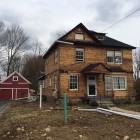News
Permit Issued to Rebuild at 22 Green Ave., Formerly Site of Historic Home
|
The town has issued the building permit for a new, 4,700-square-foot home at 22 Green Ave.—site until this summer of a 1908 house that neighbors and preservationists had fought to spare the wrecking ball. During public hearings earlier this year, where the property owner that was seeking a special permit to exceed coverage in order to keep a barn on the property (which is still there), neighbors had spoken out against plans for the new home, calling it conspicuously large, out of character with the neighborhood and potentially creating a runoff problem. Preservationists said the two-story Colonial was historically significant. The new home will include five bedrooms, four full bathrooms, a half-bath, finished basement and attic with an office and bedroom, two fireplaces, 2-car garage and open patio, according to a building permit issued Thursday. It is to be built by Stonecrest Builders for $800,000, the permit said.




